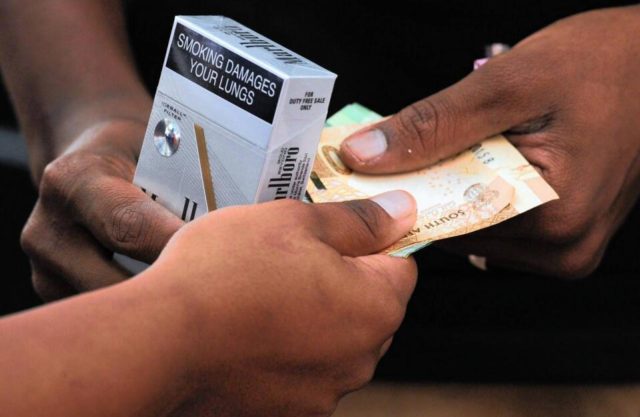Research shows that the majority of smokers have bought cigarettes during the lockdown
MOST smokers have been able to purchase cigarettes during the lockdown period, according to a recent research report published by a research unit at the University of Cape Town.
However, smokers have had to pay a substantially higher price for these cigarettes. Many smokers have also had to purchase other unfamiliar brands, as their favourite brands were often unavailable during the lockdown.
According to Professor Corné van Walbeek, the director of the Research Unit on the Economics of Excisable Products, they performed an online survey, which was completed by more than 16 000 respondents.
The collaborators on the project were Sam Filby and Kirsten van der Zee. The aim of the survey was to understand smokers’ behaviour during the lockdown period.
“Our unit has a strong public health focus and our research is often in conflict with the tobacco industry’s rhetoric. We do objective and rigorous research. We did not do this study to take sides with any grouping; we simply wanted to understand what was going on in smokers’ lives,” explained Van Walbeek.
The survey was conducted between April 29 and 11 May 11.
About 41% of respondents indicated that they had tried to quit during the lockdown period, and 39% of these were successful. Most of the people that quit during the lockdown had tried quitting previously.
It seems that, at least for them, the ban on cigarette sales has been very effective. Only 12% of respondents that had quit smoking successfully indicate that they will start smoking when they can buy cigarettes again.
Before the ban was imposed, the average smoker consumed 10 cigarettes per day. In the first two weeks of the lockdown, average consumption increased to 11 cigarettes, but after President Cyril Ramaphosa announced the two-week extension to the lockdown on April 9, average consumption decreased to nine cigarettes per day.
Nearly 90% of smokers had stocked up before the ban on cigarette sales became effective. It seems that most people did not stock up enough for the extended lockdown period, however, because average consumption decreased after the extension was announced.
More than 90% of smokers bought cigarettes during the lockdown, despite the ban on tobacco sales.
According to Van Walbeek, the distribution network through which smokers buy their cigarettes has changed considerably. Whereas formal retailers were the dominant outlets for cigarettes before the lockdown (56%), they have all but disappeared during the lockdown (3%).
The number of people using street vendors has risen from 3% before the lockdown to 26% during the lockdown, while the proportion of people relying on house shops has risen from 4% to 18%.
Meanwhile 4% of survey respondents indicated that they had purchased their cigarettes through “drug dealers”, “cigarette smugglers” or “black market traders”.
In line with the proliferation of street vendors, the percentage of people purchasing single cigarettes has more than tripled during the lockdown period. This is a serious problem for public health in South Africa, especially in a post-Covid world.
The lockdown has resulted in a transformation of the cigarette market in terms of brands. The survey results show that before the lockdown, 81% of smokers smoked brands produced by the multinational companies (MNCs), while 19% of smokers consumed brands produced by local or regional manufacturers.
During the lockdown, 63% of smokers reported smoking brands by local producers, while 37% of smokers reported smoking brands produced by the MNCs.
Whereas British American Tobacco dominated the market before the lockdown with a market share of more than 60%, the market has become more fragmented after the lockdown.
The largest seller of cigarettes during the lockdown period is Gold Leaf Tobacco, with a 30% market share, followed by British American Tobacco with 24% market share, Carnilinx with 10% and Best Tobacco Company with 9%
The average price of cigarettes reported by respondents increased by 90% from the pre-lockdown period.
Van der Zee, a collaborator on the project, explains as follows: “Using advanced statistical techniques, we were able to quantify which factors are associated with the price increase.
“We use the information that the respondents provide and see how a particular characteristic is associated with the percentage change in the price. The technique allows us to see what the impact of a particular characteristic is, independent of the other things that might change.”
The research team found that rich people reported a much larger price increase in the prices that they paid, relative to poor people.
Van Walbeek says: “One would expect this, as rich people have more money to pay the higher prices. It gives us confidence in the quality of the responses and in the modelling, because the model is confirming what we know from economics.”
The research team found that the prices reported by respondents were increasing, even during the time the survey was being conducted. They found that the price of cigarettes increased by an average of 4.4% per day over the 13 days of the survey.
In the space of two weeks, the average price has increased by more than 50%.
“Such increases in the price of cigarettes are consistent with hyper-inflation. The fact that prices are increasing so rapidly indicates that the cigarette market is in absolute chaos.
“Smokers are desperate and are willing to pay exorbitant prices to get their fix, even if it is of an unknown source,” says Van Walbeek.
People living on farms, in rural areas and towns experienced much higher increases in the price that they paid for cigarettes during the lockdown compared to people living in metropolitan areas, especially people living in informal settlements and townships.
“It seems that the informal and illicit distribution networks are more established in the metropolitan areas, and that the competition between these informal and illicit traders is tempering the price increases,” says Van Walbeek.
The last question on the survey was “Any further comments?”
Filby, another collaborator on the project, analysed each of the more than 5 000 responses and commented: “The overwhelming response was one of anger.
“Respondents were unable to understand the economic or health rationale for the sales ban. While most of the respondents acknowledged that smoking is bad for their health, they felt that the sudden imposition of the sales ban, without any cessation support, caused mental health problems because they were unable to smoke.
“Many respondents indicated increased anxiety, feeling more depressed, being less focused, and suffering from physical withdrawal symptoms.”
Van Walbeek says that the ban on cigarette sales is failing in what it was supposed to do.
“While the original intention of the ban was to support public health, the reality right now is that the disadvantages of the ban greatly outweigh the advantages.
“People are buying cigarettes in large quantities, despite the lockdown. While one should not exaggerate the revenue potential of excise taxes on tobacco products, since it contributes only 1% of total government revenue, it is foolish to not collect that revenue.
“The current sales ban is feeding an illicit market that will be increasingly difficult to eradicate, even when the lockdown and the Covid-19 crisis is over. It was an error to continue with the cigarette sales ban into Level 4 lockdown.
“The government should lift the ban on cigarette sales as soon as possible.”








